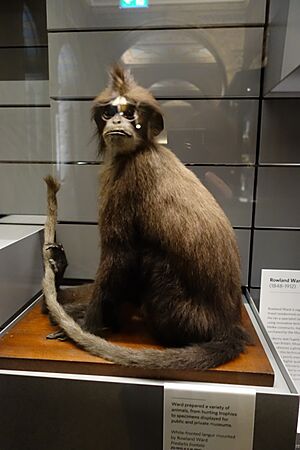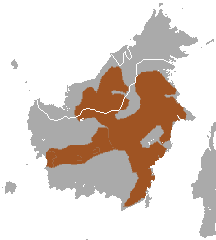White-fronted surili facts for kids
Quick facts for kids White-fronted surili |
|
|---|---|
 |
|
| Conservation status | |
| Scientific classification | |
| Genus: |
Presbytis
|
| Species: |
frontata
|
 |
|
| White-fronted surili range | |
| Synonyms | |
|
nudifrons Elliot, 1909 |
|
The white-fronted surili (Presbytis frontata) is a type of monkey found in Asia. It belongs to a group called Old World monkeys. This special monkey lives only on the big island of Borneo. Borneo is shared by the countries of Indonesia, Malaysia, and maybe Brunei.
This monkey's body is mostly grey-brown. It has a clear white spot on its forehead, which gives it its name. Its chin and lower cheeks are grey. The white-fronted surili lives in dry forests in warm, tropical places. Sadly, it is in danger because its home is disappearing.
Contents
What Does the White-Fronted Surili Look Like?
The white-fronted surili has a unique look. It has a tall ridge on top of its head, called a sagittal crest, that leans forward. The back of its body is mostly grey-brown. Its belly side is yellowish-brown. The white spot on its forehead is very noticeable.
Its tail is yellowish-grey. Its hands, feet, eyebrows, and the top of its head are blackish. There is also a light patch on its head crest. This monkey has a special stomach with many parts. This helps it digest tough plant material like leaves. It also has large salivary glands, which make a lot of spit to help with digestion.
Teeth and Body Shape
The front teeth (called incisors) of the surili are narrow. Its back teeth (called molars) are sharp and ridged. Its jaw is deep, and its face is short and wide. The thumb on its hand is small. Its back legs are longer than its front legs. Adult male surilis weigh about 5.67 kilograms (about 12.5 pounds). Adult females are slightly lighter, weighing about 5.56 kilograms (about 12.2 pounds).
Different Kinds of White-Fronted Surilis
There are two types, or subspecies, of white-fronted surilis. They are called P. f. frontata and P. f. nudifrons.
- P. f. frontata is brownish. Its arms, legs, top and sides of its head, and tail are darker. Its chin and lower cheeks are greyish. The white spot on its forehead looks like a triangle.
- P. f. nudifrons is dark greyish. Its hands, feet, and the base of its tail are blackish. Its belly and the end of its tail are lighter grey-brown. Its throat is white. The white spot on its forehead is more square-shaped. It also has a thin line of short black hairs dividing the white spot.
How They Live and Where They Live
The white-fronted surili is active during the day (this is called diurnal). It spends most of its time in trees (this is called arboreal). This monkey mainly eats leaves (this is called folivorous). But it also enjoys fruits and seeds. It prefers to eat young, fresh leaves over older ones.
Group Life and Homes
White-fronted surilis live in groups. These groups usually have between 10 and 15 monkeys. They live in tall lowland forests and hill forests. They are usually found below 300 meters (about 984 feet) in height. They have also been seen near rivers and in hill forests.
Where Can You Find White-Fronted Surilis?
The white-fronted surili lives only on the island of Borneo. They are mostly found in the southeast part of Borneo. This area is south of 3°N latitude and east of the Barito River. They have been seen in the east between the Kayan River and Banjarmasin in the south. The P. f. nudifrons subspecies has been found in central Sarawak. This includes the area between the upper Rajang River and upper Batang Lupar, and the Lanjak Entimau Wildlife Sanctuary.
Social Behavior and Reproduction
White-fronted surilis move through the forest in two main ways. They walk on all four limbs (this is called quadrupedal movement). They also move by leaping from tree to tree. Sometimes, male surilis are seen living alone.
Communication and Family Life
Male surilis use loud calls to mark their group's area. This helps other groups know where their territory is. They also communicate by touching each other. This includes social grooming, where one monkey cleans another's fur. This helps them build strong friendships within the group. When it comes to reproduction, female white-fronted surilis usually give birth to only one baby at a time.
Dangers and How We Protect Them
The white-fronted surili is listed as a vulnerable animal. This means its population is decreasing. Over the last 30 years, their numbers have dropped by more than 30%. This is mainly because people hunt them for their meat and for traditional medicine. Also, their forest homes are disappearing very quickly.
Protecting Their Homes
Many forests are being cut down to make room for palm oil farms and other human activities. To help protect them, the white-fronted surili is protected by law in Indonesia. It is also fully protected in Sarawak, Malaysia. There are at least seven protected areas where these monkeys live. One important area in Malaysia is the Lanjak-Entimau Wildlife Sanctuary.


